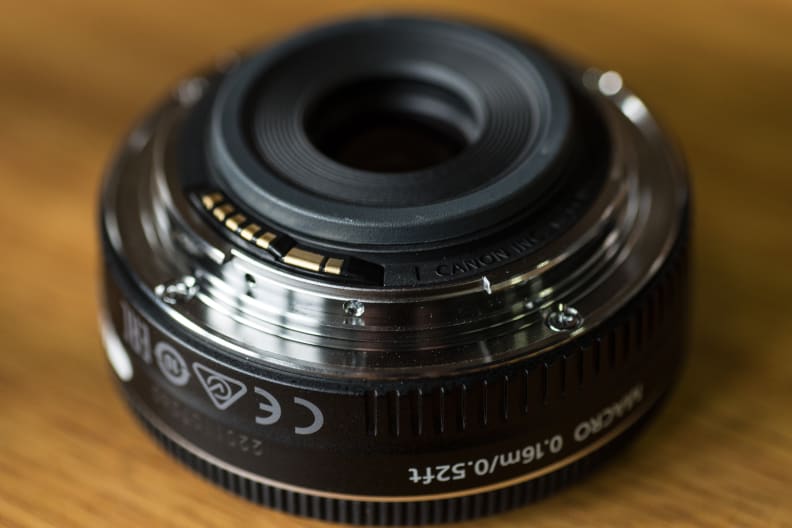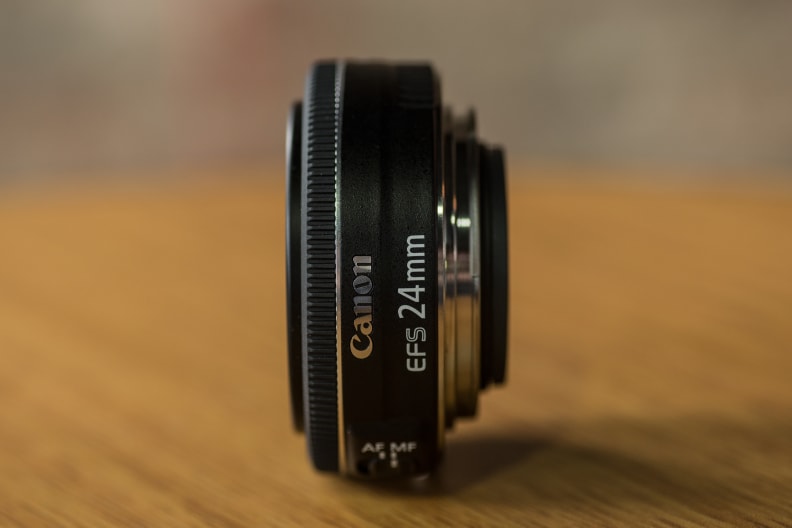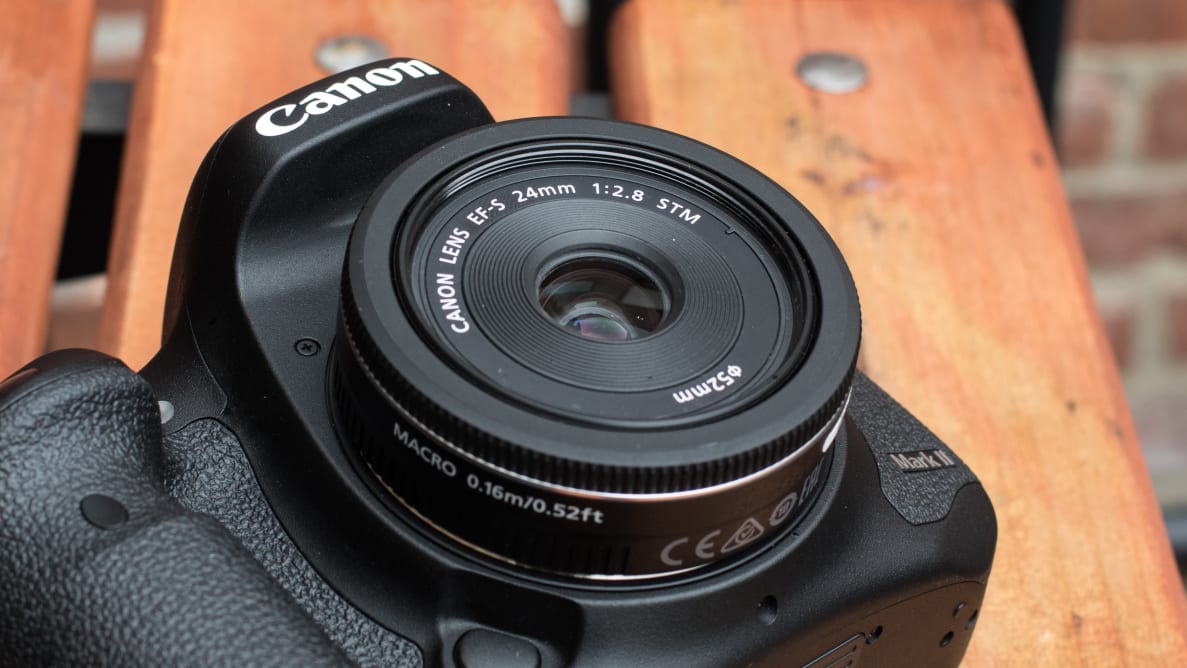The extremely portable EF-S 24mm f/2.8 is what’s commonly referred to as a “pancake” lens. Take a glance and you'll understand why—this thing is (almost) as thin as a pancake. (I’d love to meet—and marry—the person who makes inch-thick pancakes.) It's designed for those who want to carry their DSLR around all day and not wake up the next morning with a crick in their neck.
And at an asking price of just $150, it’s pretty hard to argue with the results. While the fixed 24mm (38mm effective) focal length isn’t the most versatile, it’s an effective option for capturing wide open scenes—especially when you're on the go. It’s also a very capable cinema lens thanks to its smooth, near-silent STM focusing motor. And with a maximum aperture of f/2.8, it’ll do a much better job in dim lighting than your basic 18-55mm f/3.5-5.6 kit lens.
Who's It For?
Like other EF-S Canon lenses, the 24mm f/2.8 is designed exclusively for Canon's “crop sensor” (APS-C) DSLRs, including the entry-level Rebel series and the enthusiast-oriented 70D and 7D cameras. It won’t function natively on full-frame bodies like the EOS 6D or 5D Mark III, which limits its long-term usability if you plan to upgrade to a higher-end camera down the road.

The EF-S 24mm f/2.8 STM offers solid low light performance thanks to its f/2.8 maximum aperture.
The 24mm f/2.8 produces shots a little wider than what your eyes see, making it ideal for landscapes and everyday people shots. It's relatively sharp across the entire frame, and the wide maximum aperture lets in plenty of light, which should help get clear results in dim lighting conditions. Most of all, this is a lens that should appeal to photographers who want to travel as lightly as possible.
It’s also a great option for anyone who wants a relatively wide angle of view when shooting video with a Canon DSLR, since its STM focusing motor is smooth and almost totally silent when in operation.
Look and Feel
The first thing you’ll notice when you pick up the 24mm f/2.8 is just how light it feels. Mount it on your camera and, even compared to the standard kit lens, you should have a substantially lighter package. The lens is also very small, barely protruding past the handgrip on most Rebel DSLRs.

The compact design on the 24mm f/ 2.8 makes it easy to grap-and-go.
That small footprint means there simply isn’t much room for controls, but since this is a prime lens without optical image stabilization, you really don't need many. The only time you’ll need to engage with the lens itself is to focus manually, using the wafer-thin focus ring and an AF/MF toggle switch.

The metal mount offers durability and adds a bit of weight to an otherwise light lens.
The focus ring doesn't have a feel on par with the best manual focus lenses of yesteryear, but for a digital era lens it's good enough. During my time shooting with the lens I felt a little more resistance would probably produce more precise focusing, but it's a minor complaint—especially considering it's a feature most people will hardly ever use given the tiny size and the low price of admission.
{{ photo_gallery name="Tour" }}
Image Quality
The EF-S 24mm f/2.8's best feature is its consistent performance across the frame. From the center of the image to the corners, it offers consistent sharpness, and that sharpness doesn't drop off considerably if you set the aperture wide open at f/2.8 or closed down past f/8, as some other lenses do. On the downside, it never gets as sharp as some of the better prime lenses in Canon's lineup.

EXIF: 24mm, ISO 100, 1/160, f/2.8
The EF-S 24mm f/2.8 STM also has some minor issues with both geometric distortion and vignetting. The lens produces about 1.2% barrel distortion, meaning straight lines toward the edge of the frame will bow out slightly. There's also some vignetting (darkening of the corners of the frame) at f/2.8. Chromatic aberration, which appears as colored fringing on high-contrast subjects, is the only other issue. It's moderately apparent at all apertures, but worst at f/2.8.

EXIF: 24mm, ISO 100, 1/400, f/2.8
Altogether, if you've been laboring with the standard 18-55mm f/3.5-5.6 or 18-135mm f/3.5-5.6 kit lenses from Canon, this lens will feel like a breath of fresh air. It doesn't provide the flexibility of optical zoom, but it's smaller, lighter, (generally) sharper, and has that nice smooth, quiet focus motor. You'll get better photos, better videos, and have a lighter camera that you'll want to carry around more often.
Below, you can peruse sample photos shot with the EF-S 24mm f/2.8 STM lens mounted on a Canon 7D Mark II. Click the link below each photo if you want to pixel-peep a full-size version of a given shot.
{{ photo_gallery name="Samples" }}
Conclusion
The Canon EF-S 24mm f/2.8 STM lens, like Canon's other pancake lenses, is mostly defined by what it isn’t.
It isn’t super wide-angle or telephoto, it doesn’t let you zoom, and it doesn’t have a super-wide maximum aperture like most of Canon’s most esteemed prime lenses. As an EF-S lens, it's also incompatible with Canon’s high-end, full-frame DSLRs, like the EOS 5D Mark III. But those tradeoffs create some real upsides: This lens is seriously tiny, lightweight, quiet, and cheap. At $150, it's a heck of a bargain.

For beginners and enthusiasts simply looking for something better than the kit lens, that might just be enough. Even the smallest DSLRs are pretty bulky, and one of the common reasons people put their DSLRs away in favor of smartphone cameras is that they just don’t feel like lugging the darn thing around. The EF-S 24mm f/2.8 STM puts a dent in that concern, and its 38mm effective field of view isn't too different from what you'd get with an Apple iPhone or Samsung Galaxy camera.
Frequent flyers who want a compact, lightweight lens that can reliably grab high-quality snaps of landscapes, cityscapes, and buildings will find a friend in the EF-S 24mm f/2.8 STM. But if you're just looking for a good prime lens and don't care about a little extra bulk, consider Canon's standard 50mm f/1.8. And if you really want a compact option with a little more telephoto reach, look to Canon's EF 40mm f/2.8.
Altogether, this may not be Canon's best lens, but it should prove to entry-level Canon shooters that—even for $150—you can get a lens that can dramatically change what your DSLR is capable of. Even if this lens ultimately isn't for you, it is a great entry point for anyone looking to step into the wider world of interchangeable lenses. When evaluating any lens, we focus on four key areas: sharpness, distortion, chromatic aberration, and bokeh. A perfect lens would render the finest details accurately, wouldn’t distort straight lines or produce ugly fringing around high-contrast subjects, and would create smooth out-of-focus areas.
The Canon EF-S 24mm f/2.8 is not a perfect lens, but it's a strong performer given its $150 price point. While it doesn't truly excel in any one of the four key areas, it's consistent from center to corner at virtually every aperture setting and keeps distortion and fringing to a reasonable level.
Ultimately, there are worse lenses out there, but there are also better ways to spend your money if pure performance is what you're after.
Sharpness
A lens's sharpness is its ability to render the finest details in photographs. In testing a lens, we consider sharpness across the entire frame, from the center of your images out to the extreme corners, using an average that gives extra weight to center performance. We quantify sharpness using line widths per picture height (LW/PH) at a contrast of MTF50.

Even at peak sharpness, the lens isn't so great.
When shooting in the RAW file format on the Canon 7D Mark II the EF-S 24mm f/2.8 STM fails to match up to the best prime lenses on the market. In the image center, the lens was only able to resolve about 1,300 lines at f/2.8, though that figure improves to around 1,500 lines at f/5.6 and f/8. That's what we'd call an acceptable result, though its full-frame equivalent, the EF 40mm f/2.8, showed better overall results on the full-frame EOS 5D Mark III.

Wide open, this is merely a fair lens.
In the midway and corner regions of the frame, the 24mm f/2.8 fared a bit worse. In both regions the results hovered around 1,100 lines wide open, which is acceptable, but not great. The corners improved to 1,400 lines at f/5.6 and f/8, but the middle region never showed much improvement at all. It would be a troubling result in a larger, more expensive lens, but realistically you're buying this lens for its compact design, not world-beating performance.
Distortion
We penalize lenses for distortion when they bend or warp your images image, causing normally straight lines to curve.
There are two primary types of distortion: When the center of the frame seems to bulge outward toward you, that’s barrel distortion. It's typically a result of the challenges inherent in designing wide-angle lenses. When the center of the image looks like it's being sucked in, that’s pincushion distortion. Pincushion is more common in telephoto lenses.
The EF-S 24mm f/2.8 STM exhibits mild to moderate barrel distortion, in line with a lens of its type. In our tests we recorded roughly 1.2% barrel distortion—detectable, but easy to correct with commonly available photo editing software. It's not really much to worry about, and the in-camera correction available on most Canon DSLRs will take care of it for you.
Chromatic Aberration
Chromatic aberration refers to the various types of “fringing” that can appear around high contrast subjects in photos—like leaves set against a bright sky. The fringing is usually either green, blue, or magenta and while it’s relatively easy to remove the offensive color with software, it can also degrade image sharpness.
The EF-S 24mm f/2.8's wide-angle optical design yields slightly worse chromatic aberration than we'd like. Though the issue isn't as severe as it is in some of Canon's lower-end zooms, there's moderate fringing at all apertures. It's worst at f/2.8 in the image corners.
Bokeh
Bokeh refers to the quality of the out-of-focus areas in a photo. It's important for a lens to render your subject with sharp details, but it's just as important that the background not distract from the focus of your shot.

While some lenses have bokeh that's prized for its unique characteristics, most simply aim to produce extremely smooth backgrounds. In particular, photographers prize lenses that can produce bokeh with circular highlights that are free of aspherical distortion (or “coma”).
The bokeh from the EF-S 24mm f/2.8 is simply not very appealing. Coma is a problem across much of the frame, and out-of-focus areas have a busy, nervous look. It's a poor result compared to most similar prime lenses, especially at f/2.8 with subjects close to the lens. Compared to your kit lens it is still an improvement, but there are better lenses in Canon's lineup that aren't much more expensive.

EXIF: 24mm, ISO 100, 1/160, f/2.8
You can see some of these issues in the shot above, where the background just doesn't have that creamy, smooth look that DSLR shooters crave.
Meet the tester
TJ is the former Director of Content Development at Reviewed. He is a Massachusetts native and has covered electronics, cameras, TVs, smartphones, parenting, and more for Reviewed. He is from the self-styled "Cranberry Capitol of the World," which is, in fact, a real thing.
Checking our work.
Our team is here for one purpose: to help you buy the best stuff and love what you own. Our writers, editors, and lab technicians obsess over the products we cover to make sure you're confident and satisfied. Have a different opinion about something we recommend? Email us and we'll compare notes.
Shoot us an email


